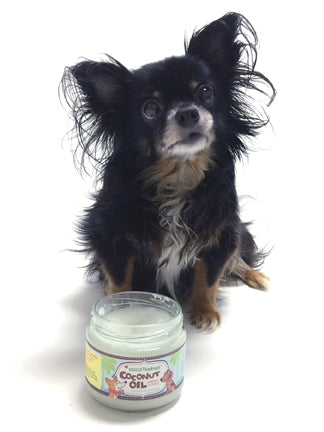Candida yeast infections (candidiasis) affect pets and people, causing uncomfortable and painful symptoms that can become serious if left untreated.
In today's post we'll explain what candida is and how yeast infections occur in the body.
We'll also highlight some of the most common symptoms associated with candidiasis in pets and explore how coconut oil can help fight candida infections and prevent them from spreading.
What is Candida?
Candida is a natural, sugar-digesting yeast that lives in your pet's mouth, nose, ears, and gastrointestinal and urinary tracts. There are many different species of candida yeasts, the most common of which is Candida Albicans.
Candida normally exists in small colonies, coexisting with other organisms including beneficial bacteria and different kinds of yeasts and microbes.
But a combination of factors can cause imbalances in the body, causing candida yeast to grow out of control. This overgrowth of candida in your pet's body can lead to yeast infections known as candidiasis.
Most instances of candidiasis are localized in one area of your pet's body such as the ears. But chronic yeast infections can occur when candida enters the bloodstream from the gut and colonizes the entire body.
What Causes Candida Infection?
Candida infections occur when your pet's immune system is compromised causing an imbalance of the body's natural flora.
Your pet's immune system can become weakened due to numerous factors. Allergies can contribute to an animal’s susceptibility to candida overgrowth, and an overgrowth of candida can also exacerbate allergies.
Many pets develop allergies or sensitivities to poor-quality, high carbohydrate foods. This can lead to an imbalanced pH which upsets the balance of bacteria and yeasts in the digestive tract.
Immune-suppressing medications, parasites, and hormonal disorders are other examples of factors that can compromise your pet's immune system and lead to candidiasis.
Candida is an opportunistic type of yeast. This means that it will take any chance to colonize and spread throughout the body if the environment is favorable for growth.

What Are the Symptoms of Candida Infection?
The symptoms of candida infection can be as varied as its causes, and different areas of the body will react differently to infection.
In the case of ear infections, excessive shaking and scratching of the head and ears is common. You may also notice a buildup of debris inside the ears. Symptoms of an oral candida infection include constant drooling and problems eating.
Excessive itching, hot spots, rashes, and open sores are typical signs of candidiasis on your pet's skin. Many pets will lick or scratch the infected area in an effort to relieve their discomfort.
Candida infection can occur both inside and outside the body. Other common symptoms include cystitis, fever, and skin discoloration.
You may also notice that your pet has a characteristic yeasty odor. Some pet owners compare the smell to corn chips, cheese popcorn, or moldy bread.
How Does Coconut Oil Fight Candida Infection?
So far in this post we've explained what candida is, looked at common causes of candidiasis, and highlighted some of its symptoms.
In this final section of the post, we'll take a look at how coconut oil helps fight candida infection and prevents it from spreading throughout the body. We'll also show you how to use coconut oil with your pets to prevent and fight candidiasis.
Coconut oil is rich is lauric acid and caprylic acid – medium-chain fatty acids (MCFAs) that have antibacterial, antiviral, antifungal, and antimicrobial properties.
The MCFAs in coconut oil have been shown to effectively kill potentially harmful microorganisms such as bacteria, viruses, fungi, and parasites. MCFAs are completely harmless to pets and people and are actually used by the body as a source of energy.
Caprylic acid is the principal MCFA in coconut oil that attacks and kills candida cells. It does this by penetrating and rupturing the cell walls of the yeast. This inhibits growth and disintegrates the yeast cell until it no longer functions.
Capric acid – another MCFA present in coconut oil – is also a powerful yeast-killer. It works in a similar way to caprylic acid, breaking down and disintegrating the cell membrane of candida yeast.
Lauric acid is the third MCFA in coconut oil that penetrates and kills candida yeast cells. When taken together as coconut oil, these three fatty acids work together to effectively eradicate candida infection.
Unlike many other antifungal treatments, the combination of MCFAs in coconut oil have been shown to kill candida yeast without leading to the development of more resistant candida strains.
How to Use Coconut Oil to Fight Candida Infection
CocoTherapy organic virgin coconut oil can help fight candida infection when taken internally and applied topically.
When taken internally, the fatty acids in the oil heal the lining of the digestive tract, improve metabolism, and fuel the body’s cells. Applied topically, coconut oil promotes healing of damaged tissue and has antimicrobial properties to aid in controlling yeast or bacterial infections on the skin.
When treating and preventing infection in your pets, be sure to choose a therapeutic grade oil such as CocoTherapy coconut oil. Our oil is sourced from our USDA-certified organic family farm in the Philippines and made in our own facility.
It’s high in lauric, capric, and caprylic acid - the MCFAs known for their antibacterial, antiviral, and antifungal properties – which makes it highly effective at preventing and treating the root causes of infection.
We recommend giving cats and dogs 1 teaspoon (5g) per 10 pounds (4.5kg) of body weight. When first introducing your pet to coconut oil, start with a very small amount and increase gradually. Some pets – especially those not used to much fat in their diets – may need a while for their digestive systems to adapt.
A small amount of virgin coconut oil can be massaged into your pet's skin if they are suffering from external symptoms of candidiasis.
When yeast infects the skin or ears, applying coconut oil topically to the infected area will help control the infection, soothe itchiness, and promote healing of damaged tissue.
Check out our previous post, Coconut Oil – a Natural Way to Fight Infections, for more information on using coconut oil to prevent and treat common infections in pets.
For more information about CocoTherapy and our coconut oil, chips, and treats for pets, check out more of our blogs.


